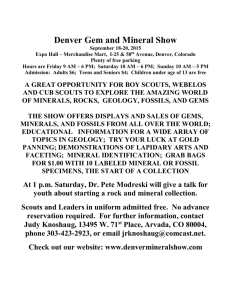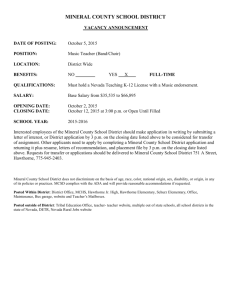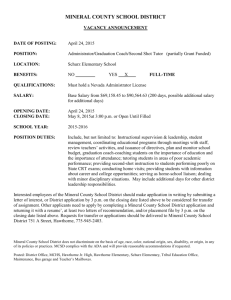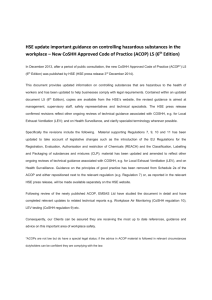Mineral Wools - Nuneaton and Bedworth Borough Council
advertisement
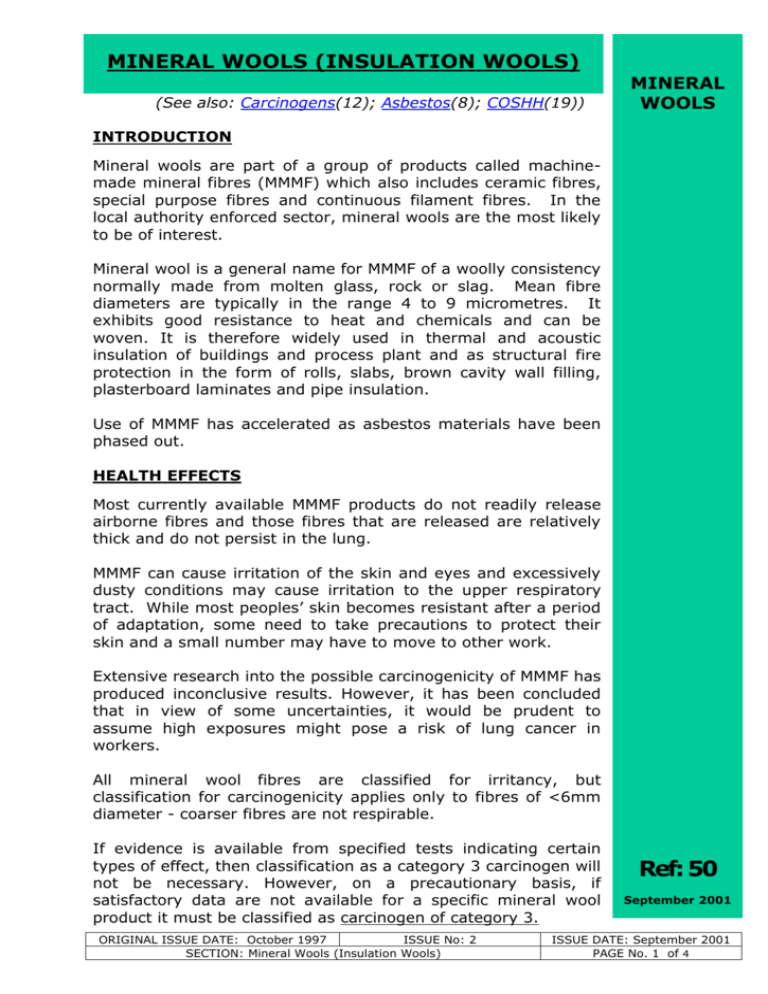
MINERAL WOOLS (INSULATION WOOLS) (See also: Carcinogens(12); Asbestos(8); COSHH(19)) MINERAL WOOLS INTRODUCTION Mineral wools are part of a group of products called machinemade mineral fibres (MMMF) which also includes ceramic fibres, special purpose fibres and continuous filament fibres. In the local authority enforced sector, mineral wools are the most likely to be of interest. Mineral wool is a general name for MMMF of a woolly consistency normally made from molten glass, rock or slag. Mean fibre diameters are typically in the range 4 to 9 micrometres. It exhibits good resistance to heat and chemicals and can be woven. It is therefore widely used in thermal and acoustic insulation of buildings and process plant and as structural fire protection in the form of rolls, slabs, brown cavity wall filling, plasterboard laminates and pipe insulation. Use of MMMF has accelerated as asbestos materials have been phased out. HEALTH EFFECTS Most currently available MMMF products do not readily release airborne fibres and those fibres that are released are relatively thick and do not persist in the lung. MMMF can cause irritation of the skin and eyes and excessively dusty conditions may cause irritation to the upper respiratory tract. While most peoples’ skin becomes resistant after a period of adaptation, some need to take precautions to protect their skin and a small number may have to move to other work. Extensive research into the possible carcinogenicity of MMMF has produced inconclusive results. However, it has been concluded that in view of some uncertainties, it would be prudent to assume high exposures might pose a risk of lung cancer in workers. All mineral wool fibres are classified for irritancy, but classification for carcinogenicity applies only to fibres of <6mm diameter - coarser fibres are not respirable. If evidence is available from specified tests indicating certain types of effect, then classification as a category 3 carcinogen will not be necessary. However, on a precautionary basis, if satisfactory data are not available for a specific mineral wool product it must be classified as carcinogen of category 3. ORIGINAL ISSUE DATE: October 1997 ISSUE No: 2 SECTION: Mineral Wools (Insulation Wools) Ref: 50 September 2001 ISSUE DATE: September 2001 PAGE No. 1 of 4 LEGAL REQUIREMENTS The COSHH Regulations 1999 apply to all forms of MMMF. A maximum exposure level (MEL) has been set; inhalation exposure to MMMF should always be reduced to a level as low as is reasonably practicable and, in any event, the MEL should not be exceeded. MINERAL WOOLS The COSHH assessment will include breaking down the work into its constituent tasks and identifying the workers involved in each, assessing the duration and level of exposure and planning the control measures to be used and identifying the level of control that is deemed to be reasonably practicable. Factors to be considered should include:* location - e.g. higher exposure in enclosed areas or working with mineral wool above head height. * materials - type will affect likely level of fibre release * duration of work. In all but the simplest cases the assessment should be written down. Insulation, construction and removal activities can create relatively high levels, which may exceed the limits if suitable precautions are not taken. Some examples of typical workplace exposures are given below as a guide only as to what can be achieved under good conditions. The average concentrations are for the time during which the process/activity is actually taking place and are not 8-hour TWA concentrations. PROCESS/ACTIVITY Hand laying of mineral wool Blowing of mineral fibre into lofts Loose fill cavity wall insulation Airborne fibre limit Total inhalable (MEL(8hrTWA) of 2 dust fibres/ml) (MEL(8hrTWA) of 5mg/m3) Less than 1 30 Less than 2 Less than 0.1 30 Less than 1 Precautions may include: Prevention - substitution with non-fibrous material, dust suppressants, sealants. Engineering controls such as local exhaust ventilation Work planning/housekeeping Personal protective equipment (PPE) - as a final measure when all other reasonably practicable measures have been taken but adequate control has not been achieved. This ORIGINAL ISSUE DATE: October 1997 ISSUE No: 2 SECTION: Mineral Wools (Insulation Wools) Ref: 50 September 2001 ISSUE DATE: September 2001 PAGE No. 2 of 4 should include eye protection, skin protection, respiratory protective equipment (either type-approved by HSE or made to an HSE approved standard) and protective clothing. MINERAL WOOLS Consideration will need to be given as to whether monitoring is required under COSHH 1999. Guidance and advice is contained in Paras 35-37 of GN (EH)46: ‘Man made mineral fibres’ and information on likely levels may be available from suppliers or manufacturers. Further information on methods may be obtained from the publication ‘Monitoring Strategies for Toxic Substances’. Laboratories carrying out MMMF counting are recommended to participate in an external quality assurance scheme. This scheme is administered by the Institute of Occupational Medicine, 8 Roxburgh Place, Edinburgh EH8 9SU, telephone 0131-667-5131. The COSHH General Approved Code of Practice (ACoP) states that the collection and maintenance of health records (i.e. health surveillance) is required for MMMF under Reg 11 (2)(b). The Appendix to the ACoP specifies what the record should contain. Employees working with or handling MMMF should be provided with suitable and sufficient instructions and training on risks to health and precautions to be taken. Insulation Work Airborne concentrations during the installation of insulation vary depending on the confinement of the work area and the type and duration of the work undertaken. The primary safeguards in such operations will normally involve the use of an appropriate standard of PPE suitable for the conditions, but the work method should also be designed to: Prevent or minimise direct skin contact Prevent MMMF from settling on work or other clothing Prevent the spread of MMMF to other work areas not normally affected Where high levels of exposure may occur e.g. blowing mineral fibres into lofts or hand laying of mineral wools in poorly ventilated lofts (30mg/m3 is common with up to 90mg/m3 being measured for short durations) the duration of exposure will need to be assessed to determine the time-weighted average, and hence the standards of PPE that will be necessary. Ref: 50 September 2001 ORIGINAL ISSUE DATE: October 1997 ISSUE No: 2 SECTION: Mineral Wools (Insulation Wools) ISSUE DATE: September 2001 PAGE No. 3 of 4 CHECKLIST - MINERAL WOOLS 1. Is there any likelihood of exposure to MMMF in your business? YES NO 2. If so, have you carried out a COSHH assessment of the work activity, including the following:(i) Likely levels of exposure? YES NO YES NO (ii) Identifying the level of control deemed to be reasonably practicable? YES NO 3. Have you established whether monitoring is required? YES NO 4. Have you confirmed details of health surveillance? YES NO 5. Have you provided suitable and sufficient instruction and training for employees? YES NO MINERAL WOOLS REFERENCE/FURTHER DETAILS *1. Guidance Note EH 46: Man-made mineral fibres (HSE)(1995) *2. L5 ‘General COSHH ACOP, Carcinogens ACOP and Biological Agents ACOP’ (1999)(£8.50)(0 7176 1670 3)(HSE Books) **3. Leaflet IND(G)163(rev1)(5/99) ‘5 Steps to Risk Assessment’ www.hse.gov.uk/pubns/indg163.pdf **4. Leaflet IND(G)136L (Rev1) (5/99) ‘COSHH - A brief guide to the Regulations’(HSE) www.hse.gov.uk/pubns/indg136.pdf *5. Guidance Note (EH)44 - Dust in the workplace: general principles of protection (HSE) *6. Booklet HS(G)53:’The Selection, Use and Maintenance of Respiratory Protective Equipment - a practical guide’ (HSE)(1998)(£9.50) 7. SIR 27 Specialist Inspector Report ‘Some Occupational Hygiene Aspects of MMMF and New Technology Fibres (Available from HSE Information Centre). 8. Guidance document HSG 173 ‘Monitoring Strategies for Toxic Substances’ (1997)(£6.95) (ISBN 0 7176 14115) * ** Available to view by prior arrangement at Nuneaton and Bedworth Borough Council, Environmental Health Services, Council House, Coton Road, Nuneaton. CV11 5AA Free copy available from Nuneaton and Bedworth Borough Council at the above address. ORIGINAL ISSUE DATE: October 1997 ISSUE No: 2 SECTION: Mineral Wools (Insulation Wools) Ref: 50 September 2001 ISSUE DATE: September 2001 PAGE No. 4 of 4


